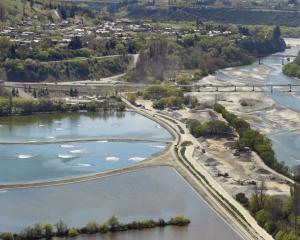The scale and cost of the $40 million Queenstown wastewater treatment plant, combined with other infrastructure projects needed in the Wakatipu basin, would make the area "less affordable for locals and visitors alike", a resource consent hearing was told yesterday.
Queenstown Lakes District Council wastewater project manager Martin O'Malley was addressing an Otago Regional Council panel, hearing evidence relating to the "most expensive infrastructure project" the council has faced.
The panel, comprising chairman Stephen Woodhead, ORC councillor Duncan Butcher and specialist Robert van Duivenboden in Queenstown, is to determine whether consents should be granted to continue the existing discharge from the Shotover wastewater treatment plant and from the new sewage treatment on the Shotover Delta, near Queenstown.
Mr O'Malley said the current consents the treatment plant is operating under were granted 10 years ago and expired last month.
Initially the council hoped to have the upgrade completed by the end of the last consent period but a series of "rather unfortunate setbacks", which could not be foreseen, had held up the process.
Because of the delay, the council was applying for two consents - one for the short-term continued operation of the ponds until an upgrade is complete, the other for a long-term consent for the proposed treatment and disposal method.
"It may well be fortuitous that these delays occurred, because the QLDC has been able to utilise knowledge, technology and undertake consultation that was not possible, or available, several years ago.
This has resulted in a far more robust and holistic approach being adopted in order to find a solution that best suits the community, stakeholders and interested and affected parties."
The delays included questions over the suitability of the proposed site, further testing and monitoring and a realisation in 2005 that a more robust analysis of all possible discharge and disposal mechanisms was required to achieve the maximum 35-year consent under the Resource Management Act.
In 2002 the council was told the long-term solution was possible to achieve with a capital expenditure of $5 million; four years later, that cost was estimated at "closer to $40 million".
Mr O'Malley said there had been "discussions, debates and frank and earnest exchanges of views" and described the reality as a "bitter pill to swallow" for many.
The extra cost could not be subsidised from elsewhere and had to be paid for by the community, developments, businesses and visitors, making the area a more expensive one in which to live and operate.
Mr O'Malley said many viewed the area as a holiday destination, investment opportunity or "some kind of cash cow", but it was also a series of vibrant communities and any expansion put pressure on those communities in terms of change, growth "and affordability to live here".












